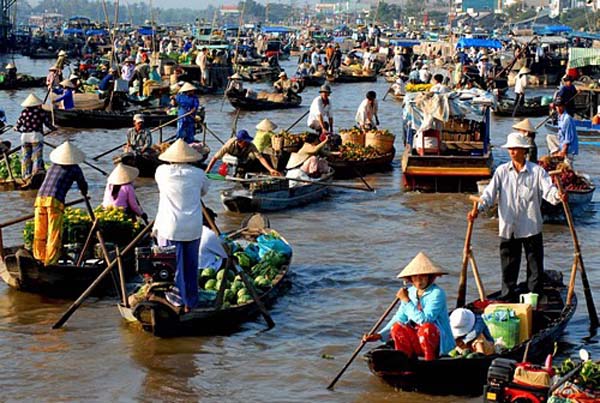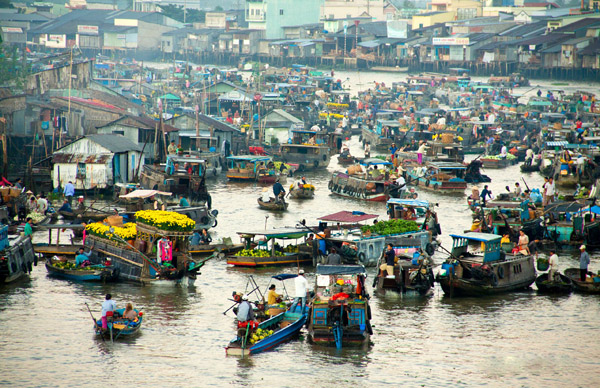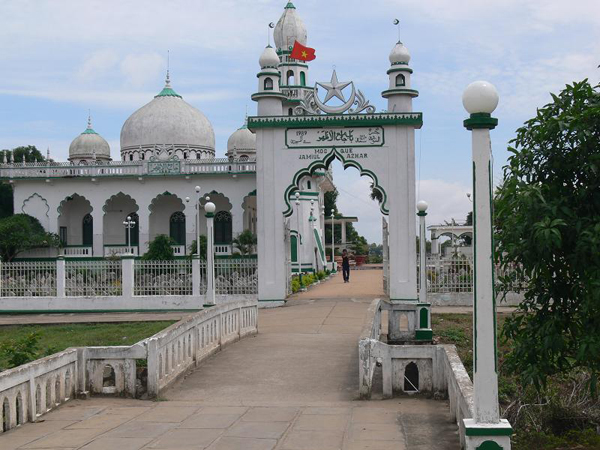My Tho and Vinh Long A convenient first stop in the delta is My Tho a sprawling market town by the banks of the Ham Luong branch of the Mekong, just 60km (37 miles) southwest of Ho Chi Minh City. After bustling Saigon, My Tho is pleasantly quiet and a good place to stay overnight while taking a boat trip to explore local waterways and islands.
In My Tho itself, the huge market provides an insight into local lifestyles. Its elaborate Cao Dai Temple is worth visiting, as are the pastel – colored colonial-period Catholic Mytho Church and the peaceful Vinh Trang Pagoda
Pushing deeper into the Mekong Delta, the next stop is Vinh Long, about 60km (37 miles) south- west of My Tho via a giant new suspension bridge across broad Tien Giang, or Upper Mekong River. This is another possible overnight stop as there are several adequate hotels and good restaurants Vinh Long is famous for its picturesque Cai Be Floating Market about an hour by boat from the town centre. The market functions from around 5am to 5pm, but it’s best to visit in the early morning.
A fascinating river trip may be made to nearby Anh Binh Island. Easily reached by small boats available for the purpose, the island is very fertile and supports many vegetable gardens and orchards. It’s pleasant to sail or stroll around, watching the bobbing non la conical hats of the local women as they tend their plots. About 2km (1 mile) south of town, by the banks of the Rach Long Canal, stands Van Thanh Mieu, a small temple dedicated to Confucius.
Can Tho and Environs
Can Tho, 34km (21 miles) and one major ferry crossing southwest of Vinh Long, is the largest town and de facto ‘capital’ of the Mekong Delta. There’s a domestic airport set amid the myriad waterways, and boat or ferry connections can be made to almost anywhere in the delta. Here, too, the presence of Vietnam’s Khmer minority begins to make itself felt. The Munirangsyaram Pagoda on Hoa Binh Street is the centre of Theravada Buddhism in the city, which has a Cambodian population of around 2,500.
There are two interesting floating markets within easy distance of Can Tho – Cai Rang, about 5km (3 miles) southeast of the city, an Phong Dien, possibly the most traditional an least motorized floating market in the delta, situated about 20km (12 miles) to the southwest. Can Tho is another good place to stay overnight.
Long Xuyen To Chau Doc
About 60km (37 miles) northwest of Can Tho, the town of Long Xuyen has little to offer, but is a necessary transit point on the way northwest to the Cambodian frontier. Nearby are the ruins of Oc Eo, an important trading port of the Kingdom of Funan, which dominated much of the Gulf of Siam coast and the Mekong Delta in the 2nd-6th centuries AD.
Beyond Long Xuyen, the road continues north – west along the banks of the Hau Giang or Bas- sac River – also known as the ‘Lower Mekong’ – passing through vast reaches of rice paddy towards the border with Cambodia’s Takeo province. Close by the frontier, on the south side of the Hau Giang, lies the city of Chau Doc. Until the mid-18th century, Chau Doc, like much of the Mekong Delta, was under Cambodian suzerainty – to this day Cambodians refer to the Mekong Delta region of Vietnam as Kampuchea Krom or ‘Lower Cambodia’.
Chau Doc still retains a border atmosphere with an interesting racial mix. The town is pre-dominantly Viet, but sustains sizeable Hoa (Chinese), and Cham and Khmer minorities. The religious mix is still more eclectic – there are Vietnamese and Chinese Mahayana Buddhists, Cambodian Theravada Buddhists, Chinese and Vietnamese Catholics, Cham Muslims, Vietnamese and Khmer Cao Dai and – Hoa Hao, an indigenous sect almost as strange as the Cao Dai.
The Chau Phu Temple, built in 1926, and the Chau Giang Mosque, which serves the town’s Cham community, is worthwhile explorations.
You may be interested in Mekong Delta tours.




